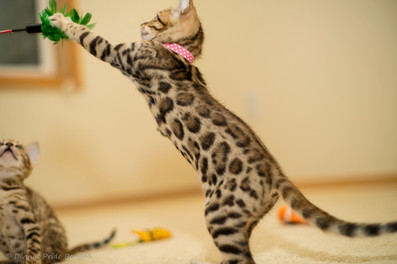
If you’re a cat lover, you'll be interested to learn about the Bengal house cat – a unique breed that offers the wild beauty of their ancestors and the affection of domestic tabby cats. In this blog post, we’ll explore the fascinating world of Bengal cats, uncovering their intelligence, similarities and differences between Bengals and tabbies, and the dog-like behavior that makes them the ultimate pet for both cat and dog fans.
Characteristics of the Bengal House Cat
Beautiful hair coats, often gold, brown, silver or white with spots, marbling, or swirl. Their shiny, short, and sleek coats require very little grooming.

An athletic and muscular build
Very smart and actually trainable
Friendly and affectionate with their pet parents
Playful, active, and full of energy
Sound interesting? Read on!
Bengal Intelligence
When it comes to intelligence, Bengal house cats outperform other cat breeds. They are very curious, inquisitive, and can be trained quickly. Some examples of their intelligence and learning capabilities include:
Ability to learn tricks, such as fetching or rolling over
Can be easily trained
Very interested in their surroundings
Amazing problem-solving skills, such as opening cabinet doors or turning on faucets
How a Bengal Compares with other House Cats
Comparing Bengal cats with the common tabby is like comparing apples with oranges – both are beautiful and affectionate, but they have their differences.
Appearance:
Bengal house cats have an exotic look with a coat featuring unusual patterns and vibrant colors, while tabbies have less of a wild look and have the classic "M" on their forehead.
Bengals have a soft fur texture that is silkier and shinier than a tabby cat's fur.
Bengal cats have two distinct coat patterns: marbled and spotted. On the other hand, tabby cats have M-shaped markings on their foreheads and a combination of stripes and spots.
Bengals have a variety of coat colors, six to be exact, although only three are recognized by The International Cat Association. Tabbies are often limited to brown, gray, or red.
Size:
Bengals are usually larger and more athletic looking than tabby cats. Males can weigh up to 15 lbs. and females between 8-10 lbs. Tabbies have a more domesticated look and size.
Personality:
Bengal house cats tend to be more outgoing, energetic, and interactive. In contrast, tabbies are often more mellow and independent.
Intelligence:
Although individual intelligence varies, Bengals are generally known for being quick learners and problem solvers, while tabbies may not demonstrate such advanced mental capabilities. More about this later.
How Bengals are Similar to Dogs
It is often said that Bengal house cats are very dog-like and it’s true. Below are some examples of this behavior.
Loyalty and Affection: Bengals often follow you looking for attention and companionship. They often snuggle with their owners, and even stretch out for belly rubs.
Playfulness: These cats love to play fetch and can be amused endlessly with toys.
Water Affinity: You know how your typical housecat doesn’t want anything to do with water? Bengals even enjoy swimming or playing in it!
Trainability: The Bengal's remarkable intelligence makes them more receptive to obedience training, learning tricks, commands, and even walking on a leash.
Social Interaction: Bengal cats are highly sociable and will even follow you from room to room, just to be near you.
Playfulness: Bengals enjoy games that involve chasing, fetching, and problem-solving.
Bengal House Cat, a Unique Feline Companion
In conclusion, Bengal house cats are a versatile, fascinating and distinctive breed that brightens cat lovers’ lives. Their intelligence, affection, and appearance are unmatched. They make a unique and engaging companion.













